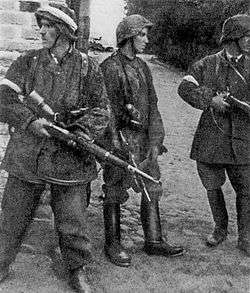Henryk Iwański
| Part of a series on the |
Underground State |
|---|
 |
|
Authorities |
|
Political organizations |
|
Military organizations |
|
Related topics |
Henryk Iwański (1902-1978), nom de guerre Bystry, was a member of the Polish resistance during World War II. He is known for leading one of the most daring actions of the Armia Krajowa (Home Army) in support of the Warsaw Ghetto Uprising. For his assistance to the Polish Jews Iwański was bestowed the title of the Righteous Among the Nations by Yad Vashem in Jerusalem in 1964.[1]
Life
Before the Second World War Henryk had reached the rank of captain in the Polish Army. Soon after Nazi Germany invaded Poland and began the Holocaust, Henryk was instrumental in the founding of the Żydowski Związek Wojskowy (Jewish Military Union).[2] Together with the rest of his family he dedicated himself to support the Jews, working through the Polish resistance (Armia Krajowa). Iwański was one of the AK members dealing with the Jews, providing them with arms, ammunition, and instructional materials smuggled through the sewers or in carts that brought lime and cement into the ghetto.
From the very first days of the Warsaw Ghetto Uprising the AK maintained contact with the Jewish fighters and tried to support them by providing supplies and launching supportive strikes against the Germans. Some of AK soldiers volunteered to join the fighters in the ghetto from the very first day of the uprising.[3] When one of the commanders of the Jewish units, Dawid Moryc Apfelbaum, sent a message to the AK informing the Poles that he had been wounded, and asking for arms and ammunition, Iwański took an AK unit (belonging to the Państwowy Korpus Bezpieczeństwa, the Security Corps) through a tunnel into the Ghetto to directly support the Jewish fighters. Among the 18 members of the unit were his brother, Wacław and Henryk's son, Roman. They entered the ghetto on April 27, 1943, bringing ammunition and other supplies and on the spot they decided to relieve some of the exhausted fighters, engaging the Germans together with the remaining members of the ŻZW on the Muranowski Square. In the fight Wacław was killed; Henryk and his son Roman were seriously wounded, Roman fatally. Moshe Arens, who has written extensively on the revolt, described the fighting:
"…heavy casualties were sustained by the ZZW, losing many of its leading fighters. Apfelbaum and Rodal were mortally wounded in fighting that raged on April 27 and 28. Iwanski's brother, Edvard, fell in Muranowska Square, his son, Roman was mortally wounded, and Iwanski himself was wounded during those days."[4]
Zbigniew, another son of Henryk fought on Karmelicka Street and died on May 3, 1943, escorting a group of Jews out of the ghetto. After being wounded, Iwański was brought from the ghetto, escorted by a group of Polish and Jewish fighters, among them Ber Mark, who later wrote a book about the Uprising. Nonetheless, Iwański returned to the ghetto at least once more, bringing another set of ammunition and supplies.[5][6][7] This was one of several actions of the Polish resistance providing assistance to the Jews in the ghetto.[6]
In 1963, for his actions Iwański was awarded the Silver Cross of Virtuti Militari, one of Poland's highest military decorations for valor. Soon later, in 1964, with his wife Wiktoria he was decorated with the medal of Righteous Among the Nations (awarded only, if there are or were, at the time of the award, Jewish witnesses who survived).
Recent questions concerning inconsistencies regarding the nature and extent of Iwanski's support for the Jewish underground have been raised. Examinations of Israeli and Polish archives have brought allegations that Iwanski exaggerated his war time activities, had made anti-Semitic and anti-Israeli radio and television broadcasts, and as an informant of Polish secret police had spied on Nazi hunter Simon Wiesenthal as an informant against the Jewish Historical Institute .[8][9]
The Polish-Israeli authors of a 2011 book on the Jewish Military Union (ŻZW) suggest that Iwański's story of heroism in the ghetto revolt is a fabrication and that he did not even have any male children. They point out that Iwański succeeded in convincing visiting journalists from abroad, most notably Chaja Lazar and Dan Kurzman, of the veracity of his story which is one of the reasons it gained credence and tremendous popularity.[10]
See also
- Jerzy Lawiński
- Henryk Woliński
- Władysław Zajdler
- List of Poles
Notes
- ↑ Henryk Iwański – his activity to save Jews' lives during the Holocaust, at Yad Vashem website
- ↑ "Artykul-Polskie Niezalezne Media". Zaprasza.net. Retrieved 2011-09-27.
- ↑ Archived July 9, 2011, at the Wayback Machine.
- ↑ Moshe Arens, "The Changing Face of Memory—Who defended the Warsaw Ghetto?" http://www.freeman.org/m_online/may03/arens.htm
- ↑ Archived September 11, 2006, at the Wayback Machine.
- 1 2 "Korbonski - Jews Under Occupation". Ucis.pitt.edu. Retrieved 2011-09-27.
- ↑ Nechama Tec (22 October 1987). When Light Pierced the Darkness: Christian Rescue of Jews in Nazi-Occupied Poland. Oxford University Press. p. 124. ISBN 978-0-19-505194-0. Retrieved 27 September 2011.
- ↑ Dariusz Libionka and Laurence Weinbaum. Deconstructing Memory and History: The Jewish Military Union (ZZW) and the Warsaw Ghetto Uprising. Jewish Political Studies Review 18:1-2 (Spring 2006).
- ↑ Yitzhak Zuckerman. A Surplus of Memory: Chronicle of the Warsaw Ghetto Uprising. University of California Press, 1993, pp. 410-12; 415.
- ↑ Dariusz Libionka & Laurence Weinbaum - Bohaterowie, hochsztaplerzy, opisywacze Wokół Żydowskiego Związku Wojskowego (Warsaw: Stowarzyszenie Centrum Badań nad Zagładą Żydów, 2011). See also: Dariusz Libionka & Laurence Weinbaum: "A Legendary Commander" Haaretz, June 22, 2007. http://www.haaretz.com/weekend/magazine/a-legendary-commander-1.223769
References
- The International Raoul Wallenberg Foundation
- The Polish Underground State: A Guide to the Underground, 1939-1945" Stefan Korbonski, pages 120-139
Further reading
- See the list in The Bravest Battle: The Twenty-Eight Days of the Warsaw Ghetto Uprising, Google Print, p.352